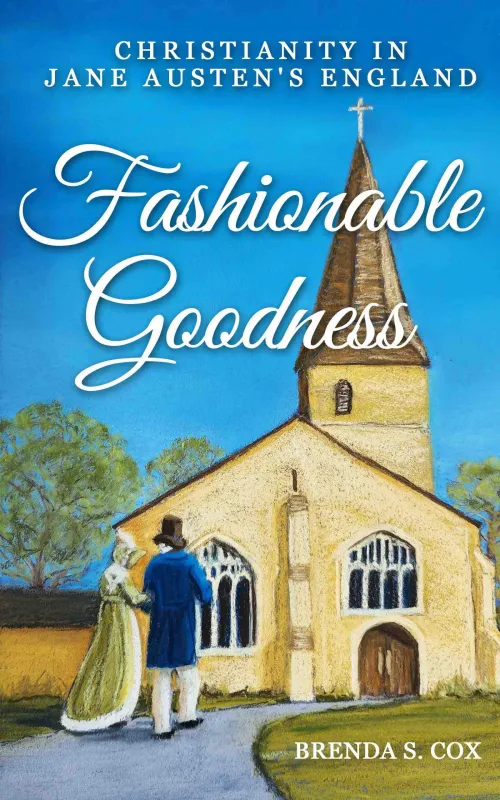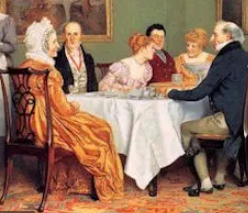
The London Season began with the sitting of Parliament after Christmas and ended in mid-June, when the Ton deserted London in droves for their country estates in order to escape the summer’s stifling heat and the city’s pungent smells.
During the height of the social whirl, attendance at parties, balls, routs, and the theatre shot up as proud Papas and Mamas strutted their white-gowned, virginal daughters in front of a host of eligible men, some longer in the tooth than others.
“We have already seen that as early as the 1730’s and 40’s many of the residents in the principal streets of the Grosvenor estate, and of course many more in other correspondingly fashionable parts of London, only spent part of each year in town, their seasonal movements being prescribed by those of the Court and by the dates of the parliamentary sessions. In the eighteenth century the number of people participating in this fashionable minuet between town and country cannot be even approximately calculated, but in the nineteenth century detailed information about the London Season was published for many years in The Morning Post, and this has been analysed for the year 1841.”
From: ‘The Social Character of the Estate: The London Season in 1841’, Survey of London: volume 39: The Grosvenor Estate in Mayfair, Part 1 (General History) (1977), pp. 89-93. URL: http://www.british-history.ac.uk/report.asp?compid=41842. Date accessed: 30 August 2006.
Wikipedia adds more insights about The Season.








[…] Marriage Mart: Regency Marriage […]
Wonderful information, thank you. I have a stupid question. How was the calendar of the young men structured during the Edwardian Era? What about the eligible young men who were at university? How were they able to attend and dance all night with debutantes in London? How did this work?
Lovely website!
RJ
RJ: No question is stupid. I am not a student of the Edwardian Era, so I am not certain how my answer pertains to that period of time. Before 1800, students at Oxford and Cambridge, especially those who came from privileged backgrounds, were notorious for partying, sleeping late, and lounging about. After 1809, a concerted effort was made to enforce rigorous study. Such discipline took a while to take hold, but by the Edwardian Era, study at Oxford had taken a more serious, academic turn.
As for dancing with debutantes in London, there were holidays, during which the young men had time to come to Town, or Brighton, or Bath, and attend balls and parties. My sense is that younger men who stood to inherit their fortunes, but whose fathers were still living, had all the time in the world AFTER their education and Grand Tour to frequent ballrooms, dinners, parties, and the opera during The Season and meet an eligible young girl of good family. The men, like Mr. Darcy, Mr. Bingley, and Mr. Willoughby, would still be in their late twenties or early thirties, young enough to look for a bride and set up a nursery.
I think I can answer RJ’s question, being an expert in Edwardiana.
The social calendar for men was dependent upon their profession and interest in certain activities. Many men were of the sporting type, who rarely came to London, instead spending their time shooting, hunting, riding, fishing, and attending country house parties where those activities were to take place. Then there were the politicians, who spent most of their time in Parliament, or in the homes of their political allies during breaks (Whitsuntide, for example). Those who were in the military were usually in far-flung places overseas (India, China, Jamaica, etc), while others were either concerned with their estates or traveling around the world (a popular pasttime for gentlemen by the last decade of the 19th century), or their own pleasures. The London season just was not the arbiter of society the way it was for most of the 19th century. By the Edwardian era, many English people took part in the social seasons of other countries: Paris, Berlin, St Petersburg, Vienna, etc.
As for young men at the universities, there were frequent breaks in the calendar, plus, the operation of Oxford and Cambridge is completely different from American colleges. For one thing, when they said they “read” for a major, they literally just read. From what I’ve uncovered, students were assigned a tutor who went over their essays and reading material to make sure they understood their lessons, and helped them write essays, etc. It wasn’t this “attendance is taken, you have some homework, come in for quizzes, etc” thing we have here. From a book I have, a young aristocrat who attended Oxford in 1888 says:
“everyday could be turned into a half-holiday; to be able to ask almost any number of friends to a party in your rooms…belong to one or two good clubs…all these things make life as good as it can be at nineteen.” So basically, young men in college had their own life going on, independent of the social season–which was really catered towards the “mature” gentleman and lady, and more important, you needed money and your own country seat to participate.
Thank you for that fabulous answer, Evangeline. I think RJ has a more complete picture with your observations.
I enjoyed your information (can’t bring myself to say ‘blog’ – it jars too much with Jane Austen’s world) on Jane Austen and Regency England very much. Just out of interest: does the word ‘Ton’ refer to the aristocracy? If so, where does it come from – I can’t think what it’s an abbreviation of. I’d like to find out more about the ‘London Season’: how it operated etc.. Most interesting.
Anyway,a lovely site. Thanks.
Rod
Rod,
According to Answers.com: “The ton meant the upper levels of London society in the Regency period. Ton comes from the French word meaning tone, as used in the phrase bon ton – good manners and fashionable style.”
I have always used the word to mean the upper crust of British Society.
This link regarding the Season sits on my site;
http://www.literary-liaisons.com/article024.html
and on Wikipedia:
http://en.wikipedia.org/wiki/Social_season
Both are fairly accurate, though I would prefer to find some historic observations for you. Thank you for your interest and your compliments. Vic
In the early to mid 1800’s, how close were most estates throughout england? Was there one estate surrounded by a village or numerous estates surrounded by a village? Did the local people work on the grand estates and return to their homes or were they tenant farmers who did not own the land but worked it?
I love the explanations available but my real question is what is the order of the classes. For example, viscounts, counts, dukes, and barons. I am not sure which one is the highest.